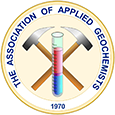Current Status of Applied Geochemistry Research in Northern Europe
The Tellus survey is a national programme to gather geochemical and geophysical data across Ireland – in other words, to examine the chemical and physical properties of our soil, rocks and water. Visit the Tellus survey site here.
A series of instructional videos made by the Geological Survey Ireland on how soil and stream samples are collected by the Tellus baseline geochemical survey in Ireland can be found here.
November 21, 2017. Report from Northern Europe: Pertti Sarala
After several quiet years in mineral exploration there have been signs of increasing activity in Fennoscandia. Numerous companies are not only working to revive former mine and exploration projects, but are also looking for new discoveries. The focus on grassroots exploration led to a rapid increase in exploration license applications during 2017. This resurgence in activity was demonstrated at the Fennoscandian Exploration and Mining conference, the biggest mining conference in the Nordic countries, which was held at the beginning of November 2017 in northern Finland (http://fem.lappi.fi/en).
In addition, the pursuit of mineral deposit types is much broader than during previous exploration cycles due to the high mineral potential of the Fennoscandian Shield, as well as the European Union’s (EU) mineral strategy of greater self-reliance for the so called critical minerals in Europe. The interest in critical minerals and elements such as In, Li, the REE, Sc, Y and PGE has increased and new brownfield and greenfield exploration campaigns have been launched targeting potential areas for these types of mineral deposits. Particularly, metal production for the battery industry is a high priority at the moment and there are several projects currently underway in Finland and Sweden.
In spite of increased exploration activity, traditional sampling programs for geochemical mapping and exploration have decreased since the last exploration boom. There are several reasons for that, including:
- Increased sampling and analysis costs;
- Tightened or restricted exploration permits;
- A focus on deeper mineral deposits;
- Increased use of portable field analyzers; and
- Development of low-impact sampling techniques.
Specifically, the use of portable XRF (pXRF) has increased rapidly and it has decreased the number of samples sent to laboratories. In addition, there are signs of increasing use of different environmentally-friendly, low-impact sampling and analytical techniques in mineral exploration using both soil and vegetation. Even snow geochemistry has shown promise in trial studies. However, there has been a general lack of knowledge regarding the effectiveness of different materials and analysis techniques in variable lithological and sedimentary environments. For that reason, several development projects funded by the EU or regional funding bodies have been implemented as joint projects with research institutes, universities and private companies.
One example is the on-going UpDeep project (Upscaling deep-buried geochemical exploration techniques into European business) funded by the EIT Raw Materials and lead by the Geological Survey of Finland (https://eitrawmaterials.eu/project/updeep/). The project promotes the use of low-impact techniques in mineral exploration and increased readiness for industry by describing best practices to implement those techniques in practical use, and by providing new tools for QA/QC, data processing and interpretation.
